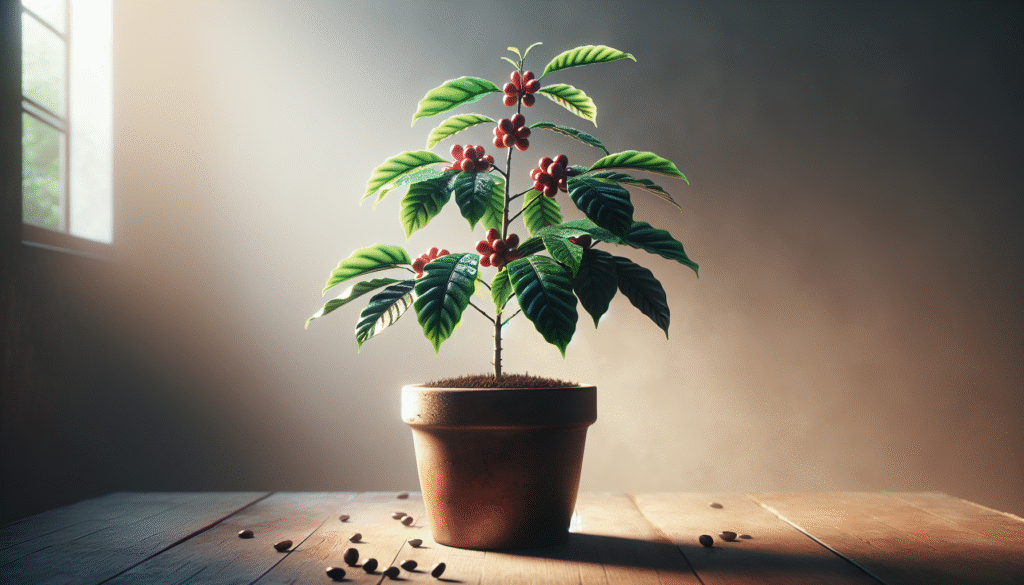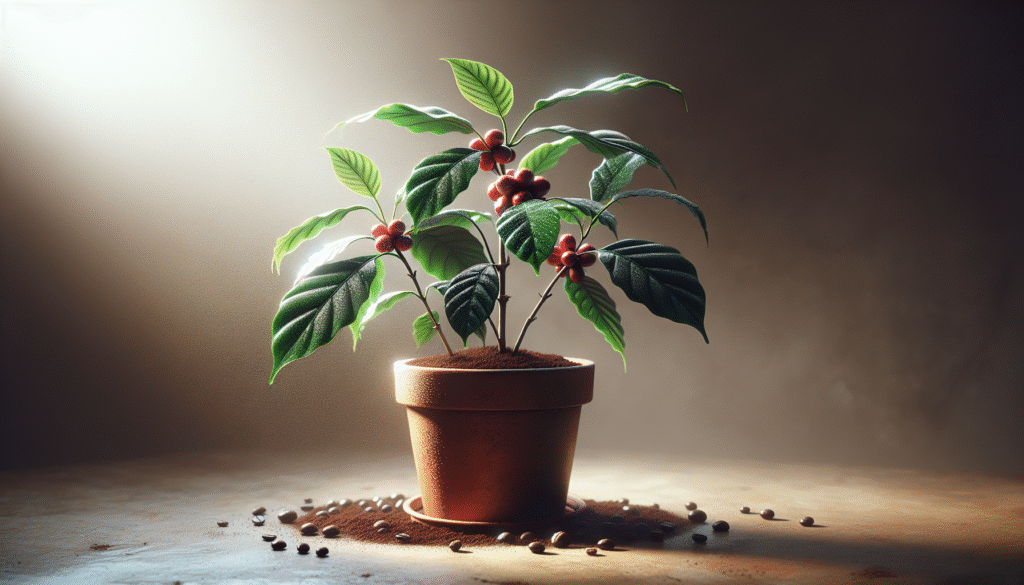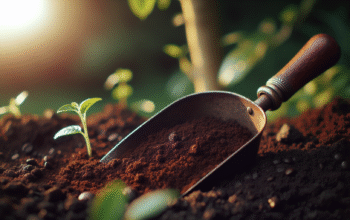Have you ever thought about growing your own coffee plant at home and turning those glossy green leaves into fragrant white blooms and sweet cherries?
Growing and Caring for the Coffee Plant
Growing and caring for the coffee plant can be a rewarding experience whether you want a decorative houseplant, a small backyard specimen, or a path toward harvesting your own coffee cherries. You’ll find that with some basic knowledge about light, water, soil, and timing, you can encourage healthy growth and even occasional fruiting in the right conditions.
Why grow a coffee plant?
You’ll get a beautiful, slow-growing evergreen with shiny leaves and fragrant flowers that can brighten your home or garden. If conditions are right, you may even harvest coffee cherries and process your own beans as a special project. Growing a coffee plant also teaches you a lot about patience and seasonal care.
Types of Coffee Plants
There are several species of coffee plants, each with different growth habits, flavor profiles, and care needs. Understanding the basics will help you choose the best one for your space.
Coffea arabica (Arabica)
Arabica is the most commonly cultivated species for high-quality coffee. It prefers cool, stable temperatures, higher elevation when grown outdoors, and more shade than robusta. You’ll notice its leaves are medium to large and the plant can be somewhat delicate in extreme heat.
Coffea canephora (Robusta)
Robusta is heartier and more tolerant of heat, pests, and diseases. It tends to produce higher caffeine and less nuanced flavor compared to arabica. If you live in a warmer climate or want an easier-to-grow outdoor plant, robusta might be a better choice.
Coffea liberica and other species
Liberica and other lesser-known species produce unique flavors and can grow into larger trees. They’re less common for home growers but can be interesting if you want something unusual or are in a region with suitable climate.
Choosing the right variety for your situation
Pick arabica if you want the potential for better-tasting beans and you can provide cooler, stable indoor conditions or shade outdoors. Choose robusta if you need a tough, heat-tolerant plant that’s more forgiving of less-than-ideal conditions. Consider dwarf or cultivar varieties if you plan to keep your plant in a pot indoors.
Where to grow your coffee plant
Coffee plants are tropical and subtropical by nature. They thrive in environments that mimic understory forest conditions: steady, bright but indirect light, warm temperatures, and relatively high humidity.
Climate and hardiness
If you live in USDA zones 10–12, you might be able to grow coffee outdoors year-round. In cooler zones, you’ll do best by keeping the plant in a container you can move indoors during cold months. Frost is a major problem for coffee; you’ll need to protect your plant from temperatures below about 45°F (7°C).
Indoor vs outdoor
You’ll have more control over temperature and humidity indoors, making container culture a popular choice. Outdoors, place your plant where it will receive dappled shade, such as under tree canopy or a shaded patio area. Outdoors you’ll need to consider local pests and diseases more actively.
Light requirements
Coffee plants like bright, indirect light. You’ll want to avoid harsh, direct afternoon sun that can scorch leaves; morning sun or strong filtered light is ideal.
Signs of too much or too little light
If your plant gets too much light you’ll see yellowing, brown spots, or crispy leaf edges. If it gets too little light you’ll notice leggy growth, smaller leaves, or fewer flowers. Adjust placement gradually so your plant can acclimate.
Temperature and humidity
Coffee prefers consistent warmth and moderate to high humidity. Aim for daytime temperatures of 65–75°F (18–24°C) and slightly cooler nights. Humidity of 50–70% helps keep leaves healthy and encourages flower production.
Managing humidity indoors
You can raise humidity with a humidifier, pebble tray with water under the pot (without letting the pot sit in water), or by grouping plants together. Misting helps a little but is temporary and not a substitute for steady humidity.

Soil and potting mix
Coffee plants need well-draining, slightly acidic soil rich in organic matter. You’ll get the best results with a mix that mimics a forest humus layer.
Potting mix recipe
A good potting mix can be:
- 40% high-quality potting soil
- 30% peat moss or coco coir (for acidity and moisture retention)
- 20% perlite or pumice (for drainage)
- 10% well-rotted compost or leaf mold (for nutrients and structure)
Adjust the ratios slightly depending on your local materials and pot drainage.
Soil pH
Aim for a soil pH around 6.0 to 6.5. Coffee will tolerate slightly lower pH but does poorly in alkaline soils. Use an acidifying fertilizer or soil amendments if pH is too high.
Watering
Consistent, even moisture is key. You’ll want to keep the potting mix moist but not waterlogged.
Watering schedule
How often you water depends on pot size, temperature, and humidity. A typical approach is:
- Water thoroughly when the top 1–2 inches (2.5–5 cm) of soil feels dry.
- Ensure excess water drains freely; never let the plant sit in standing water.
- Reduce frequency during the cooler months when growth slows.
Signs of overwatering and underwatering
- Overwatered plants show yellowing leaves, soft stems, and root rot symptoms.
- Underwatered plants show drooping, dry, brittle leaves, and leaf drop. Correct the issue by adjusting your watering routine and checking drainage.
Fertilizing
Coffee plants are moderate feeders. A regular feeding schedule during the growing season supports lush foliage and flowering.
Fertilizer types and schedule
Use a balanced, water-soluble fertilizer (e.g., 10-10-10) or a formulation for acid-loving plants. A typical schedule:
- Spring and summer: feed every 4–6 weeks.
- Fall and winter: reduce or stop feeding as growth slows.
Alternatively, you can use slow-release granular fertilizer in spring, combined with occasional liquid feed during summer. Organic options like fish emulsion or compost tea are also effective.
Micronutrients
Coffee benefits from iron and magnesium; yellowing between veins can indicate iron deficiency (chlorosis). Use chelated iron or Epsom salts (magnesium sulfate) sparingly if needed, based on symptoms or a soil test.
Pruning and shaping
Pruning helps control size, encourages branching, and can improve air circulation. You’ll get a fuller plant and more potential flower sites when you prune appropriately.
When and how to prune
- Prune in early spring before the active growth season.
- Remove dead, dying, or crossing branches.
- Tip prune to encourage branching and keep the plant compact.
- You can head back taller stems to maintain a shrub or small tree form; coffee tolerates heavy pruning well.
Training and form
Many growers maintain coffee as a multi-stemmed shrub. If you prefer a single-trunk specimen, remove competing stems and allow one leader to develop, staking as needed. Keep lower branches trimmed for easier harvesting if you plan to grow for cherries.
Repotting
Repot when your plant becomes root-bound or every 2–3 years for healthy growth. Moving to a pot one size larger provides space without sacrificing stability.
Repotting steps
- Gently remove the plant from its pot and loosen compacted roots.
- Trim any circling roots and remove old, depleted soil.
- Place in fresh potting mix and water thoroughly.
- Allow the plant to recover in a slightly shaded spot for a week before returning it to its usual light.
Propagation
You can propagate coffee plants by seed, cuttings, air-layering, or grafting. Each method has pros and cons depending on whether you want genetic clones or are growing from seed.
Propagation by seed
- Use fresh, high-quality coffee seeds (beans) for best germination.
- Soak seeds for 12–24 hours, then plant 1–2 cm deep in moist seed-starting mix.
- Maintain warm (70–80°F/21–27°C) and humid conditions; seeds can take 2–6 months to germinate.
- Note: plants grown from seed will vary genetically and take several years to fruit.
Propagation by cuttings
- Take semi-hardwood cuttings (4–6 inches/10–15 cm) with at least 2–3 leaf nodes.
- Use rooting hormone and a moist, well-draining medium like perlite and peat.
- Keep warm and humid until roots develop, usually several weeks to months.
- Cuttings produce clones of the mother plant and can fruit sooner than seed-grown plants under some conditions.
Air-layering and grafting
- Air-layering works well on larger, established plants to create a new rooted section that can be potted separately.
- Grafting is mainly used commercially to combine desirable rootstock vigor with valuable scion varieties; it’s advanced but possible for skilled hobbyists.

Flowering, pollination, and fruiting
Coffee plants produce fragrant white flowers typically after a period of ample moisture and stable conditions. These flowers then set cherries that mature over months.
Flowering triggers
A change in watering or seasonality often triggers flowering. For potted plants, consistent conditions and slight stress from reduced watering followed by thorough watering can simulate natural cues.
Pollination
Flowers are mostly self-fertile but are also visited by bees and other pollinators outdoors. If indoors, you can hand-pollinate using a small brush to transfer pollen between flowers to improve fruit set.
Fruit development timeline
After successful pollination, cherries form and typically take 6–9 months to fully ripen, depending on species and conditions. Ripe cherries are usually red (some varieties may be yellow).
Harvesting and processing coffee cherries
Harvesting and processing are hands-on steps that determine quality and flavor. If you plan to harvest cherries for coffee beans, be prepared for a multi-step process.
Harvesting
- Pick ripe cherries by hand, focusing only on the red (or ripe-colored) ones.
- Harvesting can be staggered as cherries ripen at different times on the same plant.
Processing methods
Two basic home-friendly processing methods:
- Washed (wet) process: Remove the outer flesh soon after picking, ferment the mucilage for 12–48 hours to loosen it, rinse, then dry the beans on a tray or rack until moisture is about 11–12%.
- Natural (dry) process: Spread whole cherries thinly on trays to dry in sunlight and shade as needed, turning frequently to avoid mold, until dry to the touch; remove the dried husk later.
After drying, you’ll need to remove the parchment/hull and lightly roast the green beans to make drinkable coffee. Roasting is its own skill set; start with small batches and monitor closely.
Common pests and diseases
Coffee plants can be susceptible to pests and diseases, particularly in warm, humid environments. Early detection and integrated management are important.
Pests and control (table)
| Pest | Signs | Control measures |
|---|---|---|
| Mealybugs | White cottony clusters on stems and leaves | Wipe with alcohol, use insecticidal soap, or introduce beneficial insects |
| Scale insects | Small, round, hard bumps on stems/leaves | Scrape gently, treat with horticultural oil or systemic insecticide |
| Spider mites | Fine webbing, stippled leaves in dry conditions | Increase humidity, use miticide or insecticidal soap |
| Aphids | Clusters on new growth, sticky honeydew | Blast with water, use insecticidal soap, encourage predators |
| Root-knot nematodes | Stunted growth, root galls | Use clean soil, rotate plants, consider resistant rootstocks |
Diseases and management (table)
| Disease | Signs | Management |
|---|---|---|
| Root rot (Phytophthora) | Yellowing leaves, soggy roots | Improve drainage, reduce watering, remove infected root tissue |
| Leaf rust (Hemileia vastatrix) | Orange powdery spots under leaves | Remove affected leaves, improve air circulation, fungicides in severe cases |
| Anthracnose | Dark lesions on leaves and fruit | Prune diseased parts, maintain clean area, fungicides if needed |
| Sooty mold | Black coating on leaves from honeydew | Control sap-sucking pests that create honeydew |
Troubleshooting common problems
Problems often arise from cultural issues rather than pests alone. Here’s how you can address common symptoms.
Yellow leaves
- Often due to overwatering, poor drainage, or nutrient deficiencies. Check the soil moisture and drainage and test for nutrient imbalances. Adjust watering and feed appropriately.
Leaf drop
- Sudden changes in light, temperature, or humidity can cause leaf drop. Look for stress events and stabilize conditions. Avoid moving the plant too often.
Brown leaf edges or spots
- Could be scorch from direct sun, low humidity, or salt buildup from fertilizers. Move to gentler light, increase humidity, and flush soil occasionally.
Poor flowering or fruit set
- Insufficient light, lack of pollination, or nutrient imbalances can limit flowers. Improve light, hand-pollinate if indoors, and ensure balanced feeding.
Special considerations for indoor coffee
Growing coffee indoors is more predictable but requires attention to mimic its native environment.
Light and placement
Place your coffee plant near an east-facing window or other spot with bright, indirect light. Rotate the pot occasionally to maintain even growth.
Pot size and mobility
Coffee prefers a slightly snug pot for better flowering; however, allow room for root growth over time. Using a pot with good drainage and having it mobile (with a saucer or plant caddy) helps with occasional moves for seasonal light changes.
Outdoor and garden planting
If your climate supports outdoor growth, consider planting in a sheltered, partially shaded spot with rich, well-draining soil.
Spacing and companion planting
Space plants several feet apart to allow airflow. Companion plants like bananas or shade trees can recreate an understory environment and help maintain humidity.
Mulching and soil care
Apply organic mulch to retain moisture and slowly add nutrients. Refresh mulch annually and avoid piling it against the trunk.
Using coffee plant as ornamental
Even without fruiting, coffee plants are attractive ornamentals with glossy leaves and sweet-scented flowers. You can incorporate them into container gardens, living rooms, and patios where their form and fragrance contribute to aesthetics.
Sustainability and ethical notes
If you plan to pursue beans for drinking, keep in mind commercial coffee production has environmental and social implications. Growing a plant for personal use is low impact, but if you scale up, consider sustainable sourcing for seedlings and seeds, avoid overuse of pesticides, and practice responsible water usage.
Quick reference care table
| Feature | Preferred condition |
|---|---|
| Light | Bright, indirect light; morning sun OK |
| Temperature | 65–75°F (18–24°C) day; >55°F (13°C) night |
| Humidity | 50–70% |
| Soil | Well-draining, slightly acidic (pH 6.0–6.5) |
| Water | Keep evenly moist; avoid waterlogging |
| Fertilizer | Balanced feed during growing season |
| Prune | Early spring for shape and vigor |
| Propagation | Seed, cuttings, air-layering |
| Fruiting | 2–4+ years from seed; sooner from cuttings |
Final tips and seasonal timeline
Growing coffee is a slow, rewarding process that benefits from attentive, seasonal care. Here’s a simple seasonal guide:
- Spring: Repot if needed, resume regular watering and feeding, prune for shape.
- Summer: Maintain humidity, monitor for pests, water more frequently as needed.
- Fall: Reduce fertilizer, prepare to move indoors if you live in a cool climate.
- Winter: Reduce watering, keep in bright location, avoid drafts and cold snaps.
If you aim to harvest cherries, be patient—fruiting often takes years and is influenced by consistent care and environmental cues. Celebrate small wins like healthy new growth, a burst of flowers, or an unexpected cluster of cherries.
Growing and caring for the coffee plant gives you both a beautiful ornamental and a potential connection to one of the world’s most-loved beverages. With steady attention to light, water, and soil, and a little patience, you’ll enjoy lush foliage, fragrant blooms, and possibly the satisfaction of processing your own beans. If you have questions about a specific problem or want a step-by-step walkthrough for seed germination, propagation, or roasting your first home-grown beans, tell me what you’re working with and I’ll guide you further.



